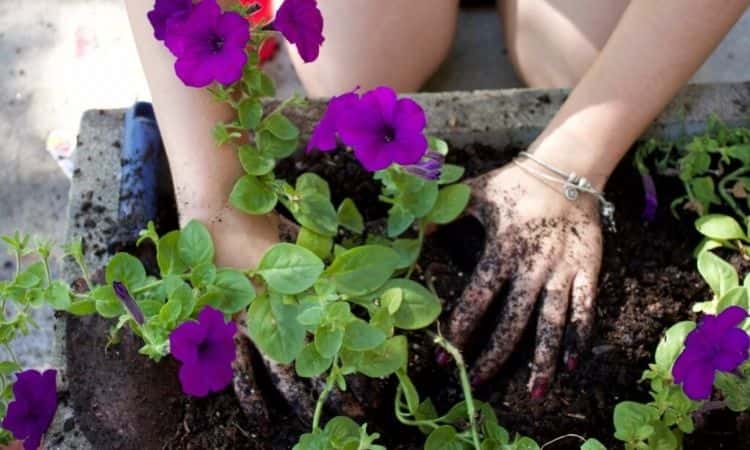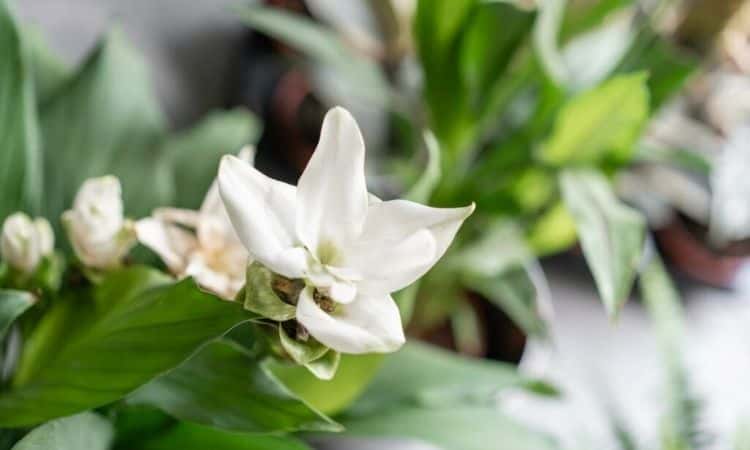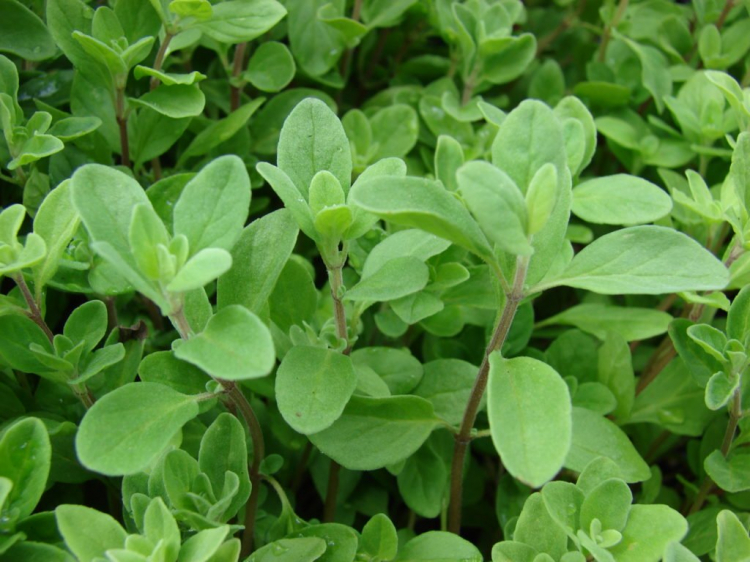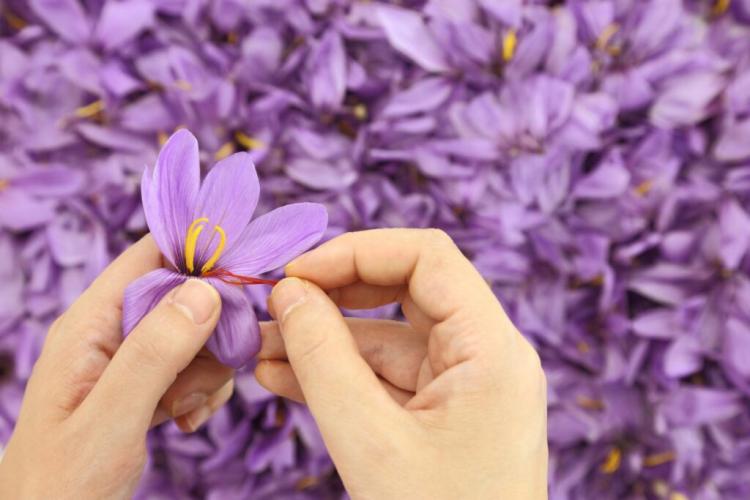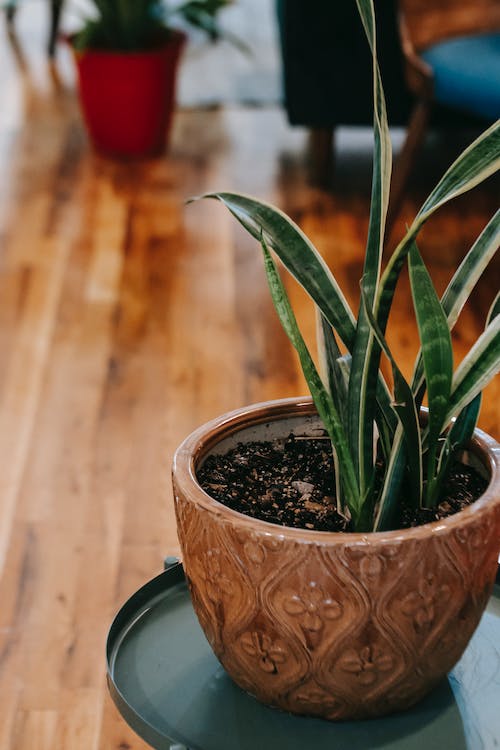Petunias Care: Planting The Best Petunias Varieties
There are both hanging and standing varieties of petunias. We show where and how best to plant petunias and what to pay attention to in the care of flowers. Whether hanging petunias in hanging baskets or standing ones in balcony boxes – petunias (Petunia) with their large, cup-shaped flowers, which shine in a wide variety of colors, should not be missing on any balcony. There are a total of 16 species, most of which originate from South America.
Their name also comes from there: the botanical name Petunia is derived from Petun, the Brazilian natives’ word for tobacco. Petunias are very closely related to tobacco and, like tobacco, belong to the Solanaceae family.
The garden petunia (Petunia × hybrida) is a hybrid produced from several species of the genus. The flowers range in hue from white to red, purple, and yellow. So there is something for everyone’s taste.
To get the most out of your petunias, there are just a few things to keep in mind when caring for these frugal flowering wonders. Here you can learn exactly what to consider when growing and caring for petunias.
The Right Location For Planting Petunias
Table of Contents
As a true South American, the petunia prefers a location in full sun. However, the plants also thrive in partial shade. There, however, not quite as many flowers are formed as in the full sun. Also ideal is a place protected from wind and rain. For example, your plants will thrive on a beautiful sunny balcony as if they had never left their home.
The right soil for petunias
Well-drained soil should be used to avoid waterlogging. Petunias prefer soil that is rich in nutrients. A rich compost or potting soil can be used when planting. Unfortunately, petunias often suffer from iron deficiency.
This can be recognized by discolored leaves with green leaf veins. This characteristic discoloration first sets in on the younger leaves. Special petunia soil is available in specialized stores to counteract iron deficiency.
This soil has a low pH, which counteracts the increase in pH caused by too hard water for watering. Hard water has many minerals that cause the pH in the soil to rise. However, iron is most available to plants in the soil at a pH of 4.5. It is also recommended to use a slow-release fertilizer when planting.
Planting Petunias In A Pot
Petunias can be classically planted in balcony boxes. Here or in hanging baskets, hanging petunia varieties with their long, flowering shoots are particularly effective. Standing petunias are particularly well suited for planting out in the garden.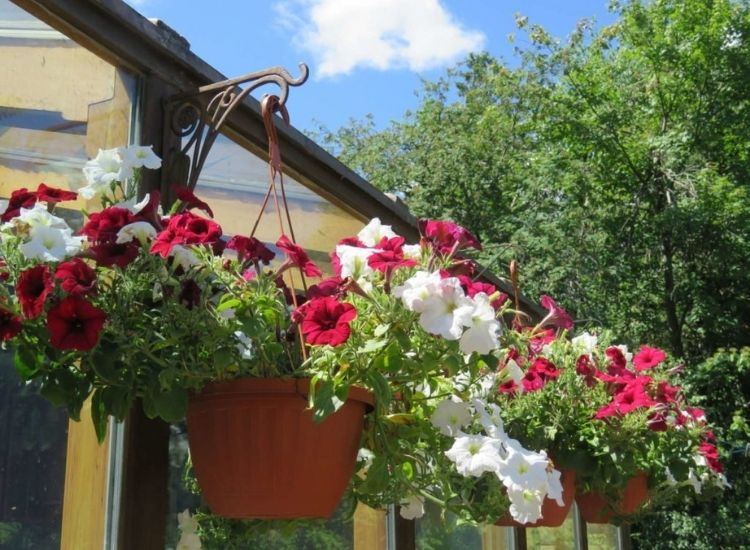
However, some hanging varieties can also be planted in beds as ground covers. When planted in a planter, it should have about 3 inches more circumference than the root ball. Good water drainage should be provided by a drainage layer at the bottom.
Hanging petunias need a little more space than the upright varieties because of their long shots. The plants are then best placed in the soil only up to the upper edge of the roots.
This should be well watered after planting so that the plants immediately feel comfortable and have enough water available. When filling up the soil, cavities are removed by pressing gently.
It is important to do this really gently, otherwise, the soil can easily become too compacted, making root growth and water drainage difficult. If several petunias are planted next to each other, a minimum distance of about 11.8 in. should be maintained between the plants.
The Right Time For Planting Petunias
Petunias are not sensitive to light frost, but as sun-loving South Americans, they easily get cold feet in spring in our climes. You should therefore not put the plants outdoors until around mid-May – then your little plants will be safe from frost.
Summary
- Location: sun to partial shade
- Protected from rain and wind
- Well-drained, rich soil
- Petunia soil to avoid iron deficiency
- Planting container: balcony box, hanging basket, tub, or planting out in bed
- Planter with good water drainage; drainage at the bottom
- Distance between petunia plants min. 11.8 in
- Plant out from mid-May (no more danger of frost)
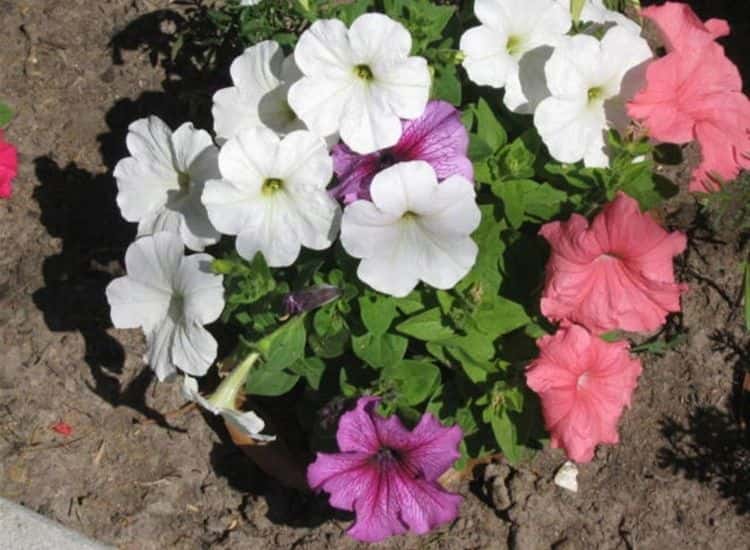
Petunia care
Petunias are very frugal plants and thus show that true beauty does not need much care. With the right knowledge, you can ensure that these natural beauties can show their best side.
Watering And Fertilize Petunias
Petunias want to be watered regularly because they need a lot of water. However, waterlogging should be avoided at all costs. To prevent the leaves and flowers of the plants from sticking together, you should water from below. Soft tap water or rainwater is best suited for this purpose.
In general, it is advisable to work a primarily organic slow-release fertilizer into the soil directly at planting. In addition, some compost can also be added to the potting soil so that sufficient phosphorus is available for abundant flower formation.
Alternatively, fertilize monthly with organic liquid fertilizer until the plants are well advanced in flowering. Thereafter, increase the fertilization frequency to every one to two weeks. A phosphate-fortified fertilizer can be used to strengthen the plants and flowers. If watering with hard water, it is best to additionally use an iron fertilizer.
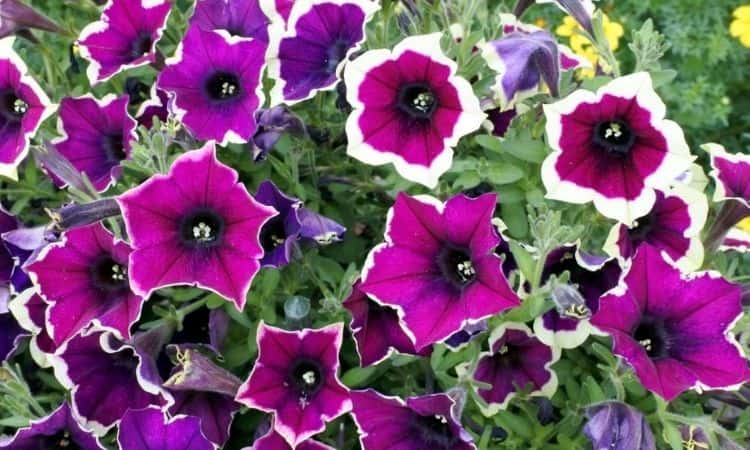
Prune petunias
In itself, petunias do not need to be pruned. However, withered inflorescences should be cleaned out regularly. This will prolong the flowering phase of the plants. If you want to overwinter your petunias, a radical pruning of the shoots to about 15 cm is done before and after overwintering.
In our article “Petunias: care and successfully overwinter” you will learn all the details about pruning before and after overwintering, as well as other details and valuable tips on proper care.
Summary
- Water a lot, but avoid waterlogging
- Water from the bottom
- Use soft tap or rainwater
- Use an organic slow-release fertilizer (at planting and after 2 months later). Alternatively: fertilize monthly with commercial liquid fertilizer until flowering is well advanced, then every 1 to 2 weeks
- Strengthening of the plants with phosphate fertilizer
- Additional fertilization with iron fertilizer
- Cleaning out faded inflorescences in summer
- Radical pruning before and after overwintering
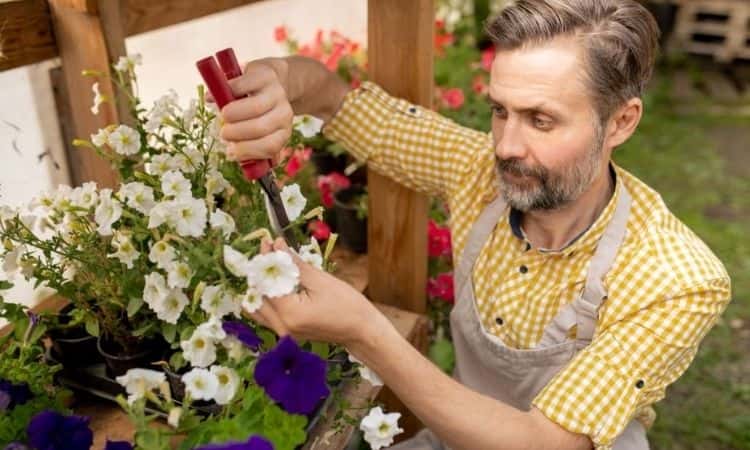
Propagate Petunias By Cuttings
Cuttings are best pruned in the summer. For this purpose, 4 in. long side shoots are cut off. The leaves are removed (except for the top pair of leaves).
Either place the cuttings in lime-free water until they take root or put them directly into a pot with soaked growing soil. As soon as the cuttings sprout again, enough roots have formed to repot the plantlets into a larger planter. Starting in February, acclimate the petunias by placing them outside on frost-free days. Planting is done from mid-May when there is no longer a danger of frost.
Summary
- Cuttings are best pruned in the summer.
- Use shoots 4 in. long
- Remove all leaves except the top pair of leaves
- Place in a glass with lime-free water until roots have formed and then put in pots with soaked growing soil OR plant directly in the pots
- Propagation was successful when the cuttings sprout at the top
- Repot into larger planters and continue to cultivate as adult petunias.
- Acclimatize cuttings before planting out in mid-May
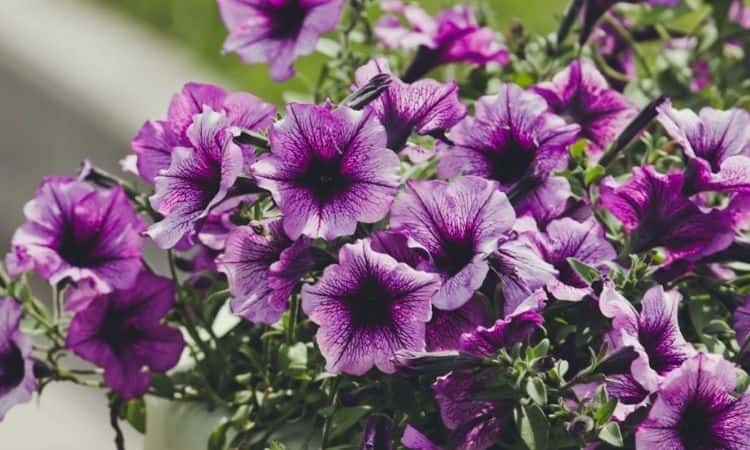
Sowing and propagating petunia seeds
Petunia seeds can be easily harvested by yourself. You can find out exactly how this works in our special article on propagating petunias. If this is too much effort for you or if you simply don’t own any petunias yet, you can simply buy the seeds in a specialist shop.
Sowing seeds is carried out from February. For this purpose, a sowing tray is filled with germ-free sowing soil. The tiny black seeds are mixed with dry quartz sand and spread evenly over the soil with sufficient spacing.
Since petunias are light germinators, a maximum of a fine layer of soil is spread over the seeds. The temperature should not fall below 68 °F during germination. At lower temperatures, it will take considerably longer. The soil is kept moist with a water sprayer.
Germination takes place under a foil hood in a bright location without direct sunlight. From germination on, the foil hood must be lifted briefly every day for ventilation. From the formation of two pairs of leaves, the plantlets are pricked out or transplanted individually into small pots.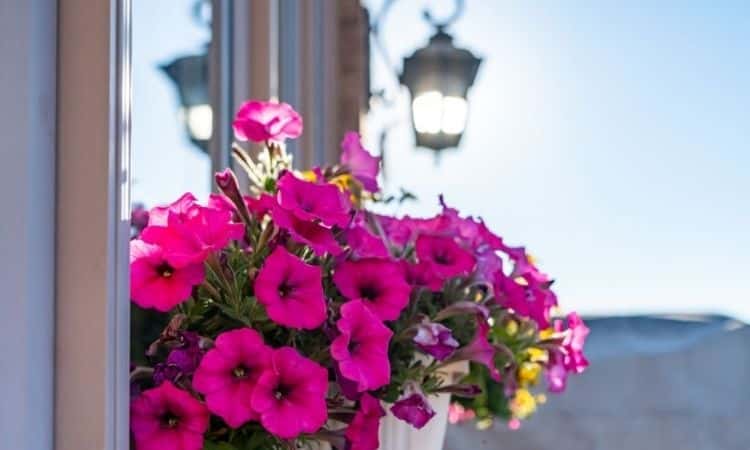
The plantlets must be acclimatized before moving outside. To do this, they are placed outside during the day and brought back inside in the evening. From the middle of May, the plants can finally go outside.
Summary
- Sowing from February in a sowing tray with germ-free sowing soil.
- Spread the seeds on the soil (be careful with light germination!)
- Optimal germination temperature: min. 68 °F
- Keep soil evenly slightly moist with a water sprayer
- Cover sowing tray with foil hood (from germination on ventilating 1x daily)
- Bright location without direct sunlight
- From the formation of the 2nd pair of leaves: prick out or transplant individually into small pots.
- Acclimatization of the plantlets before planting outdoors
- Planting outdoors from mid-May (no more danger of frost)
Petunia varieties: hanging and standing petunias
The different varieties are traditionally divided into four groups of varieties, of which ‘Grandiflora’ and ‘Multiflora’ are the most important. Petunia varieties differ greatly from each other not only in terms of their growth habit. They also vary in their flower shape, color, and size.
There are varieties with small or large, single or double flowers, star-shaped, fringed, or more rounded petals. We have compiled a selection of particularly beautiful petunia varieties for you.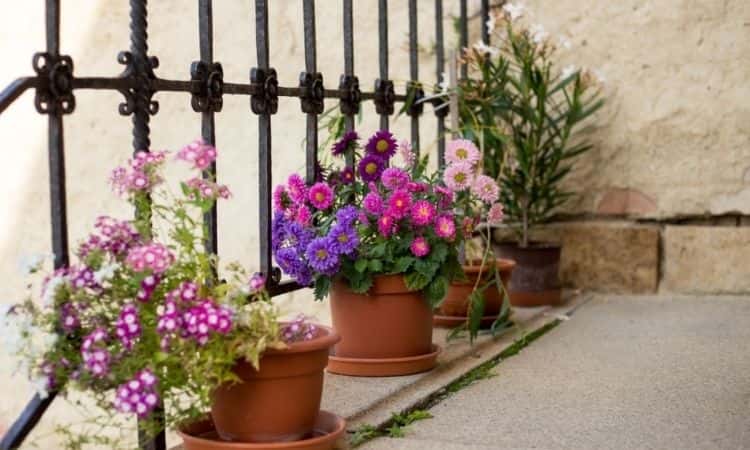
Hanging petunia varieties
Hanging specimens are the balcony classic, as their shoots grow beautifully over the boxes and tubs. They have beautiful, large, and usually showy flowers. Some varieties are also available as mini-petunias.
They have much smaller leaves and flowers, but overall the same size. Watch out: Nana hybrids of hanging petunias are very susceptible to rain and wind.
- Night Sky: As the name suggests, the large flowers of this variety are reminiscent of a night sky filled with stars. The violet-blue base color of the flower is peppered with white spots that resemble twinkling stars. No two blooms are alike, which makes this variety especially fascinating to the viewer. It was even awarded the FLEUROSTAR in 2015/2016. Hanging variety with shoots up to 40 in. long.
- Lightning Sky: The flowers of this variety have a white eye and a dark, crimson, and star-like edge with striking white speckles. Hanging variety with 15 – 23 in long shoots.
- Viva petunias are among the very special varieties with their double flowers. Here, double also means double flowering power. Despite their large flowers, they are very weather resistant and the variety is available in different color variations. Hanging variety with shoots 47 in. long.
- Chocolina: This variety with its rather small, chocolate-colored blossoms looks bite-sized (still, please don’t snack on them). It has a bushy, only slightly hanging habit with shoots about 18 in. long.
- Daybreak: Surrounded by pink morning glories, the yellow eye of mini petunia ‘Daybreak’ is at its best. It has a drooping habit with shoots up to 24 inches long.
- Pirouette Red: The Pirouette Red is a representative with double flowers. The red-eye is edged with a beautiful white. It grows pendulous with shoots 11 – 15 in. long.
- Big Time Blue: This variety has a comparatively plain appearance with its dark blue flowers, but is particularly robust and undemanding in care. The hanging shoots grow to about 39 in. long.
- Double Pink/White: These are mini petunias with double flowers, which are already all the rage in the USA. Not without reason, considering that the flowery shoots of the plants can grow over 39 in. long.
- Burgundy Star Wave: The flowers of this hanging petunia are intense burgundy with star-shaped white stripes emanating from the center. The hanging petunia reaches a shoot length of 31.4 in.
- Chameleon Double Pink Yellow: This hanging mini petunia changes flower color depending on the season. The spectrum ranges from yellow to red to orange. The plant forms hanging shoots of 15.7 – 23.6 in.
Why are petunias leaves turning yellow? You can read in this article
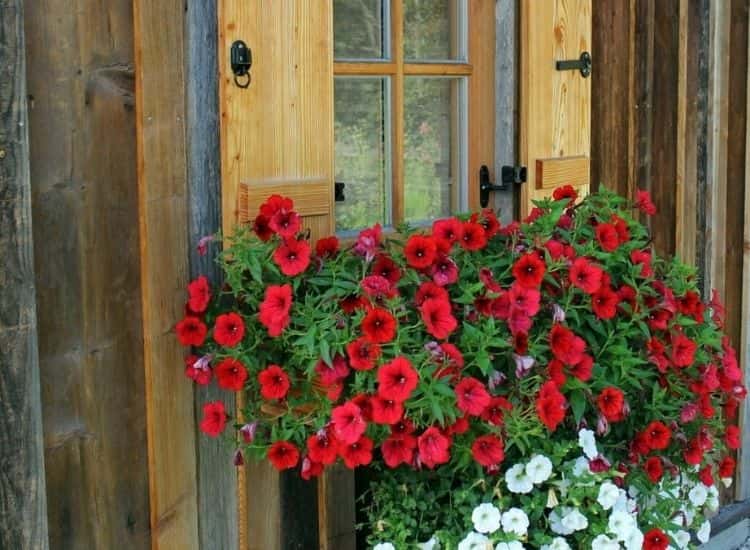
Standing petunia varieties
Standing petunias are rather small plants, but they bloom beautifully and in many colors. They grow upright like a small bush and are suitable as bedding plants as well as for container planting.
- Amore Queen of Hearts: Here the name says it all: with red hearts on a yellow background, each individual flower proclaims a message of love. It reaches a growth height of 15.7 in.
- Crazytunia Stonewashed: With this variety, no two blooms look alike. The color palette ranges from bold to soft purple to creamy yellow. It is hardy, weather-resistant, vigorous, and continuous flowering. The height of growth reaches 11.8 – 19.6 in.
- Duet Double Petunia: The double flowers convince with the play of colors of their salmon, pink and white tips. Care should be taken for a protected location. The variety has a growth height of 15.7 in.
- Mirage Red Morn: Makes any bed shine with its red-edged flowers with white eyes. Here a growth height of 15.7 in. is reached.
Petunias overwinter
Most petunias that are available in stores here are annual plants. Until the first frost we enjoy their flowers, but then they start their last walk to the compost. But does this really have to be done? The answer is no, it doesn’t have to. The plants can also be overwintered, as already indicated in the section “Pruning petunias”.
Petunias need to move to protected winter quarters before the first frost. This is the case in September or October. The plants are cut back to a short length of 7.8 in. and overwintered in a bright place at 41 – 50 °F.
When overwintering, the plants are watered only so that the soil does not dry out completely. In addition, fertilizer is not applied. Then, starting in February, the hibernators are slowly awakened by placing them outside during the day on frost-free days. From mid-May, when there is no longer any danger of frost, they can then finally move outside again.
